
Yoichi OhiraGioco del fuoco, 1999
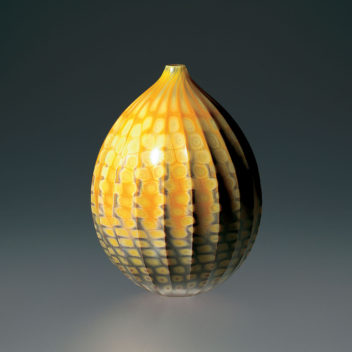
Yoichi OhiraGioco del fuoco
Vessel from the Metamorfosi series. Handblown glass rods and murrine. Surface lightly finished at the carving wheel.
Engraved: Yoichi Ohira m. L. Serena 1/1 unico 1999.
7 5/8 in. high (19.4 cm)
Bibliography and comparative texts:
R. Linzeler, 1922, p. 666;
C. Carrà , 1923, p. 67;
R. Linzeler, 1923, p. 83;
R. Papini, 1930, n. 570;
G. Mariacher, 1967, p. 98;
R. Barovier Mentasti, 1982, n. 252;
Mille anni…, 1982, n. 503;
F. Deboni, 1984, p. n. 70;
W. Neuwirth, 1987, nn. 7, 104;
A. Dorigato, 1986,
p. 71;
F. Deboni, 1989, n. 1;
L’arte del vetro, 1982, n. 307;
M. Heiremans, 1993, n. 191;
M. Barovier, R. Barovier Mentasti,
A. Dorigato, 1995, n. 15;
A. Venini Diaz de Santillana, 1996, n. 1;
R. Barovier Mentasti, 1998, n. 25;
A. Venini Diaz de Santillana, 2000, n. 1;
Olnick Spanu, 2000, n. 8;
Olnick Spanu, 2001, n. 13.
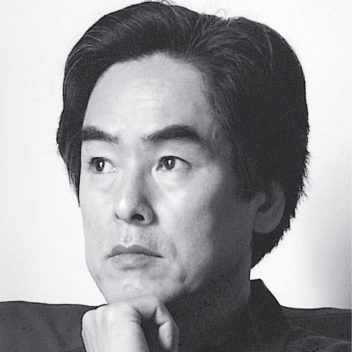
Yoichi Ohira 1946–
Yoichi Ohira was born in Japan and moved to Italy in 1973. After working as an apprentice at the Kagami Crystal Company in Tokyo, Ohira graduated in Sculpture from the Accademia di Belle Arti di Venezia with a dissertaion on the aesthetics of glass. In 1973, he began working with Egidio Costantini's Fucina degli Angeli and participated in numerous collective and personal exhibitions, presenting sculptures made with the combination of plated metal and glass. In 1987, he started a collaboration as a designer with the Vetreria de Majo in Murano. That same year, Ohira was awarded the Premio Selezione at the Premio Murano. He began working as an independent artist in the early '90s, creating magnificent one-of-a-kind pieces, which he made in collaboration with the skillful maestro glassblower Livio Serena from Murano. He has participated in the most important international exhibitions and his works are greatly appreciated by private collectors as well as many public museums. Yoichi Ohira's work is, today, part of the permanent collections of museums such as the Victoria and Albert Museum of London, the Musée des Arts Décoratifs in Paris, the Metropolitan Museum of Art in New York, the Koganezaki Glass Museum in Shizoka, Japan, and many others.
Yoichi OhiraGioco del fuoco, 1999
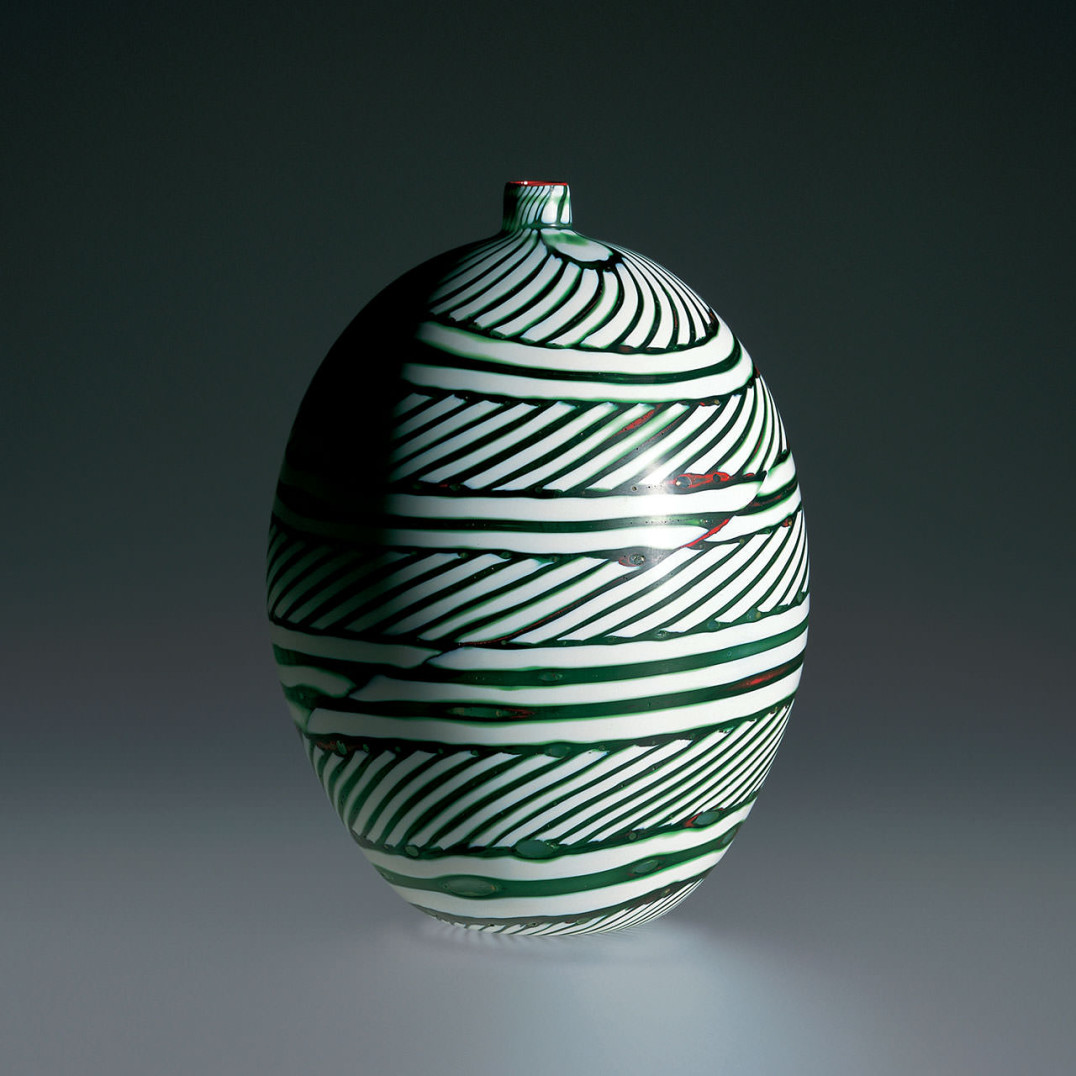
Yoichi OhiraA canne bianche e verdi, 1997
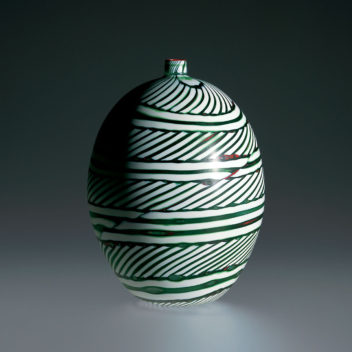
Yoichi OhiraA canne bianche e verdi
Vessel in glass crafted with lattimo and green rods with inclusion of powders. Surface lightly finished at the carving wheel.
Engraved: Yoichi Ohira m. L. Serena 1/1 unico 28.4.1997 murano.
8 1/4 in. high (21 cm)
Bibliography and comparative texts:
R. Linzeler, 1922, p. 666;
C. Carrà , 1923, p. 67;
R. Linzeler, 1923, p. 83;
R. Papini, 1930, n. 570;
G. Mariacher, 1967, p. 98;
R. Barovier Mentasti, 1982, n. 252;
Mille anni…, 1982, n. 503;
F. Deboni, 1984, p. n. 70;
W. Neuwirth, 1987, nn. 7, 104;
A. Dorigato, 1986,
p. 71;
F. Deboni, 1989, n. 1;
L’arte del vetro, 1982, n. 307;
M. Heiremans, 1993, n. 191;
M. Barovier, R. Barovier Mentasti,
A. Dorigato, 1995, n. 15;
A. Venini Diaz de Santillana, 1996, n. 1;
R. Barovier Mentasti, 1998, n. 25;
A. Venini Diaz de Santillana, 2000, n. 1;
Olnick Spanu, 2000, n. 8;
Olnick Spanu, 2001, n. 13.

Yoichi Ohira 1946–
Yoichi Ohira was born in Japan and moved to Italy in 1973. After working as an apprentice at the Kagami Crystal Company in Tokyo, Ohira graduated in Sculpture from the Accademia di Belle Arti di Venezia with a dissertaion on the aesthetics of glass. In 1973, he began working with Egidio Costantini's Fucina degli Angeli and participated in numerous collective and personal exhibitions, presenting sculptures made with the combination of plated metal and glass. In 1987, he started a collaboration as a designer with the Vetreria de Majo in Murano. That same year, Ohira was awarded the Premio Selezione at the Premio Murano. He began working as an independent artist in the early '90s, creating magnificent one-of-a-kind pieces, which he made in collaboration with the skillful maestro glassblower Livio Serena from Murano. He has participated in the most important international exhibitions and his works are greatly appreciated by private collectors as well as many public museums. Yoichi Ohira's work is, today, part of the permanent collections of museums such as the Victoria and Albert Museum of London, the Musée des Arts Décoratifs in Paris, the Metropolitan Museum of Art in New York, the Koganezaki Glass Museum in Shizoka, Japan, and many others.
Yoichi OhiraA canne bianche e verdi, 1997
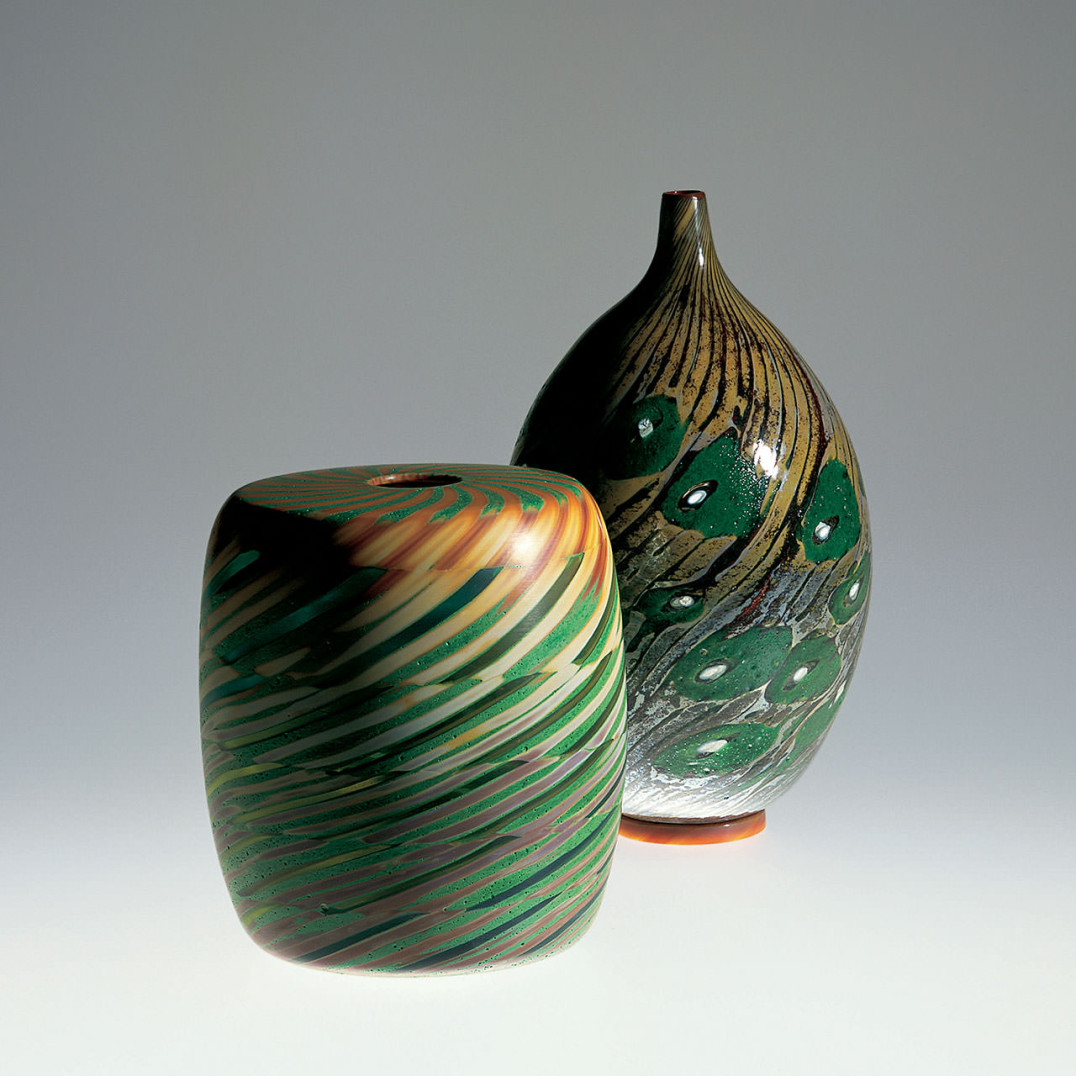
Yoichi OhiraFinestre, 1998
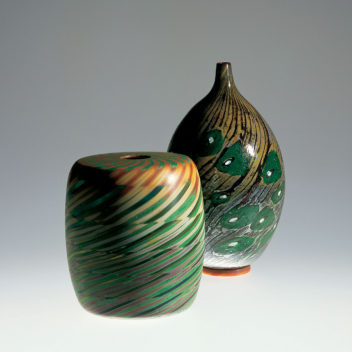
Yoichi OhiraFinestre
Vessel composed of multicolored rods with inclusion of powders and transparent green murrine. Surface lightly finished at the carving wheel.
Engraved: Yoichi Ohira m. L. Serena 1/1 unico 04 Dec. 1998 Murano.
6 1/2 in. high (16.5 cm)
Vessel from the series Pasta vitrea composed of brown rods and green and lattimo murrine with inclusion of powders. Surface lightly finished at the wheel. Foot and mouth in orange pasta vitrea.
Engraved: Yoichi Ohira m. L. Serena 1/1 unico 10.04.1998 Murano.
9 3/4 in. high (24.8 cm)
Bibliography and comparative texts:
R. Linzeler, 1922, p. 666;
C. Carrà , 1923, p. 67;
R. Linzeler, 1923, p. 83;
R. Papini, 1930, n. 570;
G. Mariacher, 1967, p. 98;
R. Barovier Mentasti, 1982, n. 252;
Mille anni…, 1982, n. 503;
F. Deboni, 1984, p. n. 70;
W. Neuwirth, 1987, nn. 7, 104;
A. Dorigato, 1986,
p. 71;
F. Deboni, 1989, n. 1;
L’arte del vetro, 1982, n. 307;
M. Heiremans, 1993, n. 191;
M. Barovier, R. Barovier Mentasti,
A. Dorigato, 1995, n. 15;
A. Venini Diaz de Santillana, 1996, n. 1;
R. Barovier Mentasti, 1998, n. 25;
A. Venini Diaz de Santillana, 2000, n. 1;
Olnick Spanu, 2000, n. 8;
Olnick Spanu, 2001, n. 13.
A vessel composed of lattimo glass canes with inlays of cristallo murrine. The surface is finished with a fine velato.
Engraved: Yoichi Ohira m. L. Serena 1/1 unico 1999 Murano..
10 in. high (25.5 cm)
Bibliography and comparative texts:
R. Linzeler, 1922, p. 666;
C. Carrà , 1923, p. 67;
R. Linzeler, 1923, p. 83;
R. Papini, 1930, n. 570;
G. Mariacher, 1967, p. 98;
R. Barovier Mentasti, 1982, n. 252;
Mille anni…, 1982, n. 503;
F. Deboni, 1984, p. n. 70;
W. Neuwirth, 1987, nn. 7, 104;
A. Dorigato, 1986,
p. 71;
F. Deboni, 1989, n. 1;
L’arte del vetro, 1982, n. 307;
M. Heiremans, 1993, n. 191;
M. Barovier, R. Barovier Mentasti,
A. Dorigato, 1995, n. 15;
A. Venini Diaz de Santillana, 1996, n. 1;
R. Barovier Mentasti, 1998, n. 25;
A. Venini Diaz de Santillana, 2000, n. 1;
Olnick Spanu, 2000, n. 8;
Olnick Spanu, 2001, n. 13.

Yoichi Ohira 1946–
Yoichi Ohira was born in Japan and moved to Italy in 1973. After working as an apprentice at the Kagami Crystal Company in Tokyo, Ohira graduated in Sculpture from the Accademia di Belle Arti di Venezia with a dissertaion on the aesthetics of glass. In 1973, he began working with Egidio Costantini's Fucina degli Angeli and participated in numerous collective and personal exhibitions, presenting sculptures made with the combination of plated metal and glass. In 1987, he started a collaboration as a designer with the Vetreria de Majo in Murano. That same year, Ohira was awarded the Premio Selezione at the Premio Murano. He began working as an independent artist in the early '90s, creating magnificent one-of-a-kind pieces, which he made in collaboration with the skillful maestro glassblower Livio Serena from Murano. He has participated in the most important international exhibitions and his works are greatly appreciated by private collectors as well as many public museums. Yoichi Ohira's work is, today, part of the permanent collections of museums such as the Victoria and Albert Museum of London, the Musée des Arts Décoratifs in Paris, the Metropolitan Museum of Art in New York, the Koganezaki Glass Museum in Shizoka, Japan, and many others.
Yoichi OhiraFinestre, 1998
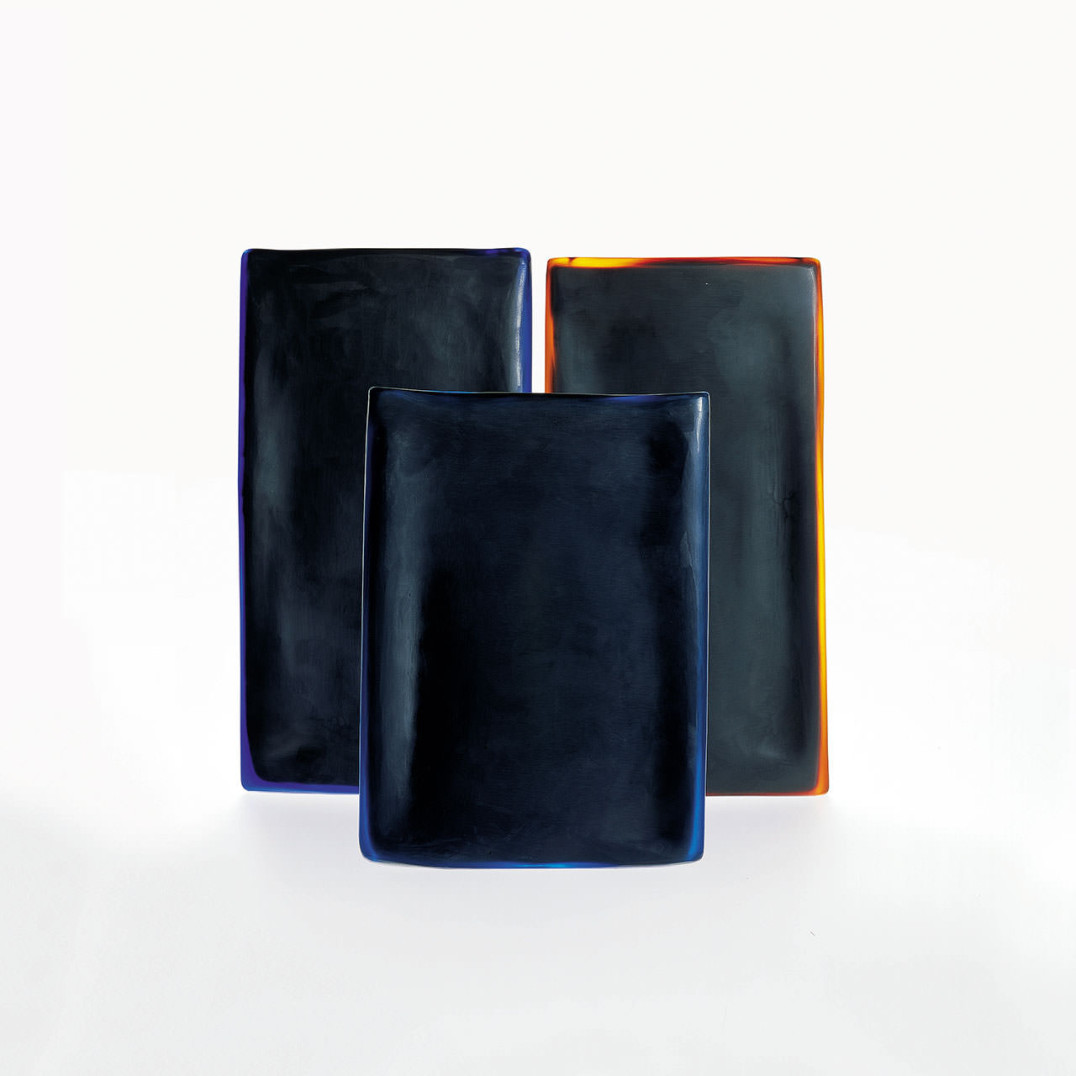
Laura Diaz de SantillanaMetamorfosi, 1999

Laura Diaz de SantillanaMetamorfosi
Three black glass rectangular sculptures. The ones in the left and center have a turquoise blue edge, the one on the right amber.
Engraved: LAURA DE SANTILLANA 1999.
17 1/8 in. high x 9 1/4 in. x 1 1/2 in. (43.5 x 23.5 x 3.8 cm)
12 7/16 in. high x 8 7/8 in. x 1 1/2 in. (31.5 x 22.5 x 3.8 cm)
16 3/4 in. high x 8 7/8 in. x 1 1/2 in. (42.5 x 22.5 x 3.8 cm)
Bibliography and comparative texts:
R. Linzeler, 1922, p. 666;
C. Carrà , 1923, p. 67;
R. Linzeler, 1923, p. 83;
R. Papini, 1930, n. 570;
G. Mariacher, 1967, p. 98;
R. Barovier Mentasti, 1982, n. 252;
Mille anni…, 1982, n. 503;
F. Deboni, 1984, p. n. 70;
W. Neuwirth, 1987, nn. 7, 104;
A. Dorigato, 1986,
p. 71;
F. Deboni, 1989, n. 1;
L’arte del vetro, 1982, n. 307;
M. Heiremans, 1993, n. 191;
M. Barovier, R. Barovier Mentasti,
A. Dorigato, 1995, n. 15;
A. Venini Diaz de Santillana, 1996, n. 1;
R. Barovier Mentasti, 1998, n. 25;
A. Venini Diaz de Santillana, 2000, n. 1;
Olnick Spanu, 2000, n. 8;
Olnick Spanu, 2001, n. 13.
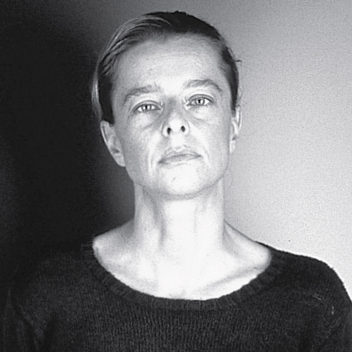
Laura Diaz de Santillana 1955–
Born in Venice, Laura Diaz de Santillana attended the School of Visual Arts in New York. After working as a graphic designer at the design firm of Vignelli Associates in 1976, she returned to Italy and began an active collaboration with Vetreria Venini & C., founded by her grandfather, Paolo Venini. At the workshop, managed with a spirit of great openness by her father, Ludovico Diaz de Santillana, her work brought her in close contact with the many Italian and foreign artists who came to the furnace in those years. During that period, she used the techniques of Murano to create refined works with unusual colors, among which the plates in vetro mosaico deserve particular mention. From 1985 to 1993, she was the designer and artistic director of Eos and later worked as designer for Rosenthal and for Ivan Baj. Further developing her own artistic identity through the creation of original works, lately she has focused her attention on the sculptural qualities of the material, which is often finished in singular textures. De Santillana's meditated study of color has produced original solutions. She has participated in numerous exhibitions in Europe, the United States, and Japan, winning widespread consensus. Several of her works have been acquired by public and private collections such as the Corning Museum of Glass, the Museum für Kunst und Gewerbe in Hamburg, and the Museo Vetrario di Murano.
Laura Diaz de SantillanaMetamorfosi, 1999
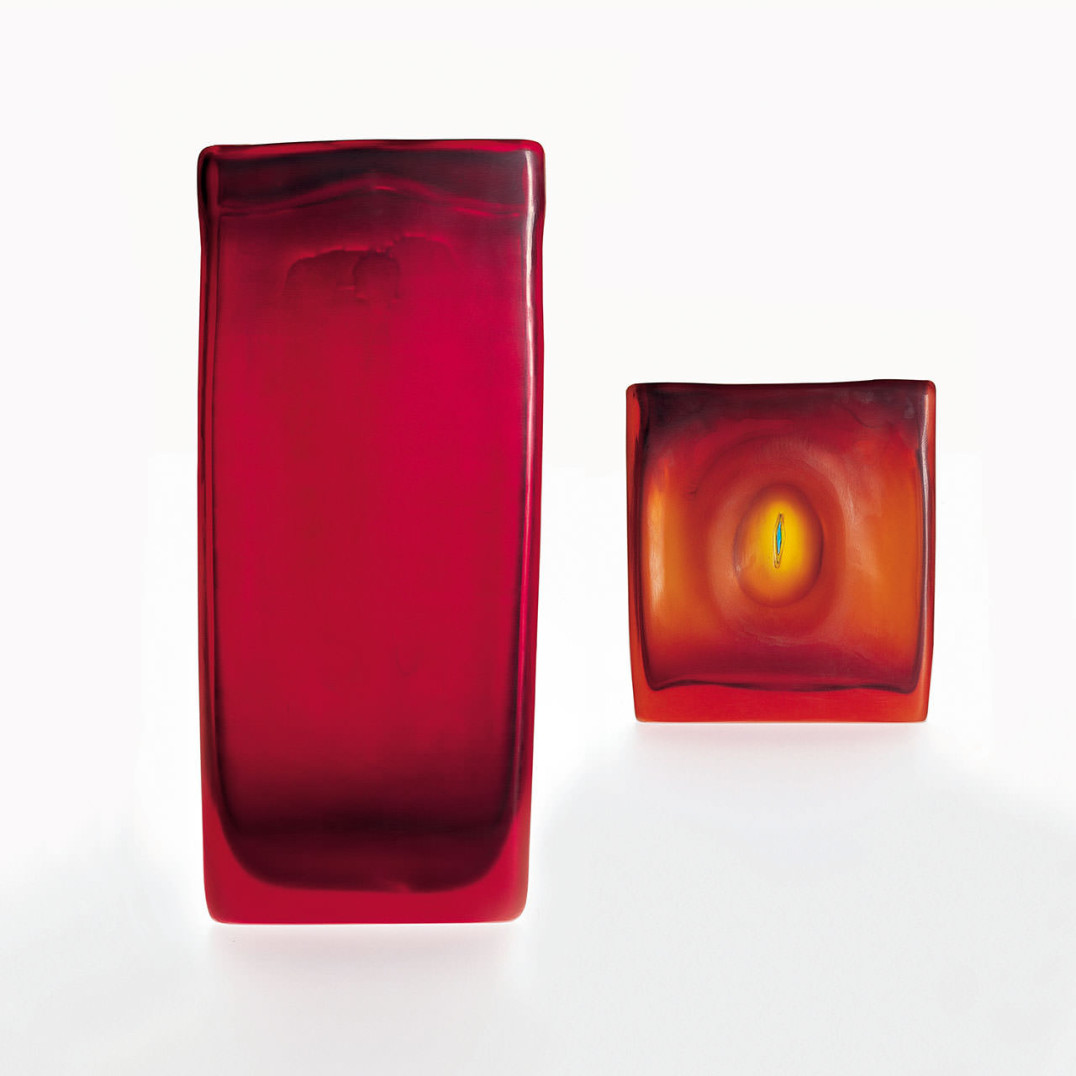
Laura Diaz de SantillanaT15, T5 L'occhio, 1999
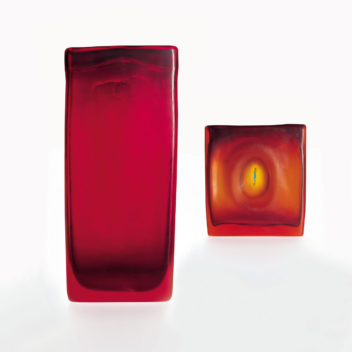
Laura Diaz de SantillanaT15, T5 L'occhio
A sculpture composed of translucent red glass.
Engraved: Laura de Santillana.
20 in. high x 8 15/16 in. x 1 5/8 in. (50.8 x 22.7 x 4.2 cm)
Sculpture in opaque amber glass. The occhio, eye in the center is in transparent turquoise glass.
Engraved: Laura de Santillana.
Bibliography and comparative texts:
R. Linzeler, 1922, p. 666;
C. Carrà , 1923, p. 67;
R. Linzeler, 1923, p. 83;
R. Papini, 1930, n. 570;
G. Mariacher, 1967, p. 98;
R. Barovier Mentasti, 1982, n. 252;
Mille anni…, 1982, n. 503;
F. Deboni, 1984, p. n. 70;
W. Neuwirth, 1987, nn. 7, 104;
A. Dorigato, 1986,
p. 71;
F. Deboni, 1989, n. 1;
L’arte del vetro, 1982, n. 307;
M. Heiremans, 1993, n. 191;
M. Barovier, R. Barovier Mentasti,
A. Dorigato, 1995, n. 15;
A. Venini Diaz de Santillana, 1996, n. 1;
R. Barovier Mentasti, 1998, n. 25;
A. Venini Diaz de Santillana, 2000, n. 1;
Olnick Spanu, 2000, n. 8;
Olnick Spanu, 2001, n. 13.
Glass sculpture in cristallo glass. Each piece blown a canna volante with inclusions of gold leaf. Iridized surface.
Engraved: Patrizia Molinari 2000 or 2001
Each piece
Ø; 7 7/8 in. (20 cm)
6 in. high (15 cm)
Exhibitions:
2001, Rome, Collocazioni Domestiche, S.M.I.T.
2002, Venice, Stanze di Vetro-Glass Rooms, Fondazione Bevilacqua LaMasa
2003, Camerino, Stanze di Vetro-Glass Room, Palazzo Pierbenedetti
2003, London, A Touch of Glass, Italian Cultural Institute
Bibliography and comparative texts:
Barbara Martusciello, Patrizia Molinari S.M.I.T. Rome 2001
Stefano Cecchetto, L’inquietudine dei carichi sospesi-Fragili Esistenze di Riflesso, Stanze di Vetro, Fondazione Bevilacqua La Masa, Venice 2002
Massimo Donà , Dell’arte in trasparenza. Il vetro come metafora di un esistere “eroicamente estetico” Stanze di Vetro Fondazione Bevilacqua La Masa,
Venice 2002
Marco Romanelli, Abitare no. 423 December 2002 issue

Laura Diaz de Santillana 1955–
Born in Venice, Laura Diaz de Santillana attended the School of Visual Arts in New York. After working as a graphic designer at the design firm of Vignelli Associates in 1976, she returned to Italy and began an active collaboration with Vetreria Venini & C., founded by her grandfather, Paolo Venini. At the workshop, managed with a spirit of great openness by her father, Ludovico Diaz de Santillana, her work brought her in close contact with the many Italian and foreign artists who came to the furnace in those years. During that period, she used the techniques of Murano to create refined works with unusual colors, among which the plates in vetro mosaico deserve particular mention. From 1985 to 1993, she was the designer and artistic director of Eos and later worked as designer for Rosenthal and for Ivan Baj. Further developing her own artistic identity through the creation of original works, lately she has focused her attention on the sculptural qualities of the material, which is often finished in singular textures. De Santillana's meditated study of color has produced original solutions. She has participated in numerous exhibitions in Europe, the United States, and Japan, winning widespread consensus. Several of her works have been acquired by public and private collections such as the Corning Museum of Glass, the Museum für Kunst und Gewerbe in Hamburg, and the Museo Vetrario di Murano.